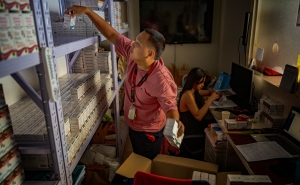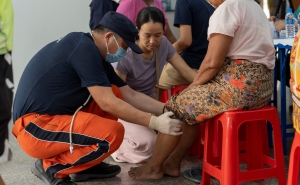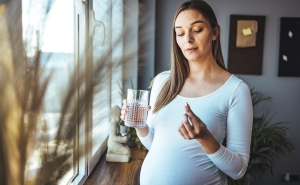Alumni Spotlight: Hilary Robbins, MSPH ’12, MHS, PhD ’18
Robbins co-leads the Risk Assessment and Early Detection Team at the WHO’s International Agency for Research on Cancer.

Hilary Robbins, MSPH ’12, MHS, PhD ’18, presenting at the 2025 G7 Cancer conference, “Poor Prognosis Cancers: From Resignation to Revolution."
Hilary Robbins graduated from the Bloomberg School of Public Health with her MSPH in International Health in 2012, and with her PhD in Epidemiology and concurrent MHS in Biostatistics in 2018.
Currently, Robbins works as a scientist and joint lead of the Risk Assessment and Early Detection (RED) Team at the World Health Organization’s International Agency for Research on Cancer (IARC). Her team, whose research contributes to primary, secondary, and tertiary cancer prevention, consists of 16 scientists, fellows, and staff from 14 countries. Within the team, she also co-lead’s the Lung Cancer Cohort Consortium (LC3) which brings together data on 3 million research participants from 26 prospective population cohorts on four continents, and biospecimens from a subset of participants. Recently, their work in the LC3 developed and validated a protein biomarker panel to improve risk assessment for lung cancer screening.
Robbins and her team received the 2024 Annals of Epidemiology Best Overall Paper Award for their paper “Design and methodological considerations for biomarker discovery and validation in the Integrative Analysis of Lung Cancer Etiology and Risk (INTEGRAL) Program” published in the Annals of Epidemiology. Their paper highlights robust and innovative approaches to develop biomarkers for early lung cancer detection.
What led you to pursue your MHS in Biostatistics, while concurrently working on your PhD in Epidemiology?
When I began my PhD, I already held a master’s in international health from the Bloomberg School, during which I had completed much of the core PhD coursework in epidemiology and biostatistics. I had also completed a two-year fellowship at the National Cancer Institute (NCI), where I had analyzed diverse types of cancer-related data, including registry linkage, biomarker, and cohort data. Working at the NCI, I found that I frequently bumped up against the limits of my biostatistical training. When I returned to Bloomberg to pursue my PhD, it was an obvious choice to pursue the MHS in biostatistics. The coursework from my prior master’s created the space and time, while my experience at the NCI created the motivation.
What aspects of the Biostatistics MHS program did you find most useful? How did it help prepare you for your career?
For me, the most important impact of the Biostatistics MHS program was an unexpected one. I found some of the coursework very challenging and I studied relentlessly leading up to the comprehensive examination—I was terrified of failing. On the day of the exam, I was six weeks pregnant with my daughter and had intense morning sickness (a misnomer, as it lasted all day). It was the shock of a lifetime when I received the Kocherlakota Award for the highest score on the master’s level exam. It had a profound impact on me, because I had always been held back by my ‘imposter syndrome’ in biostatistics. The confidence I gained from the award helped me see that one’s ability to immediately understand complicated formulas or theories is not what’s important. Instead, a strong knowledge of foundational biostatistical concepts, coupled with an epidemiologist’s intuition, creates a skillset that can be applied to almost every scenario in population health research.

Hilary Robbins working with her Risk Assessment and Early Detection (RED) team members.
What has been your most satisfying job experience using your biostatistics background?
I have been working at the International Agency for Research on Cancer, part of the WHO, for seven years. I co-lead a team focused on cancer risk assessment and early detection. Our research involves analysis of complex data to assess cancer causes, develop and evaluate cancer risk prediction algorithms, and quantify the clinical utility of risk assessment tools for early cancer detection. The biostatistical aspects of this work range from basic association and regression analyses to complex imputation, inference, and quantification of uncertainty. Applying my background to these problems has been highly satisfying, especially when I am supervising the work of students and fellows. Since they come from all over the world, they arrive with diverse prior biostatistical training. Through the problems that arise in our research together, I encourage them to solidify their own knowledge of foundational biostatistical concepts, so they are better equipped for their future careers.
What reasons might you give to encourage a prospective student to get their MHS in Biostatistics from the Bloomberg School?
In my view, the primary reason to pursue a concurrent MHS in biostatistics—if it applies to your career goals—is to raise your level of independence for confronting biostatistical problems. My MHS training did not eliminate the need for me to seek additional biostatistical input, but it substantially increased the scope and complexity of problems where I am methodologically confident on my own. Now that I lead large, international research projects, this increases the overall efficiency of my team.
What was your favorite thing about being a part of the Department of Biostatistics?
To turn the question around: being part of the Department of Biostatistics was one of my favorite things about studying at BSPH. During my 2014–2018 studies, the department was a positive environment, with a high level of camaraderie and an egalitarian approach to ideas and solutions. When I encountered biostatistical problems in my epidemiology research that I didn’t know how to solve, I would pop into the weekly department coffee gathering and usually leave with a solution. Being part of two different departments also gave me the opportunity to reflect on their differences in leadership and organization, and the associated pros and cons, which has influenced how I lead my own team years later.
What do you enjoy most about working in public health?
Working in public health—specifically cancer research—I never worry about whether my work is important. Cancer research at IARC/WHO is independent from private interests, which lends particular importance to my team’s research on biomarkers and risk tools for cancer screening and early detection. We are also completely international, which means that in my daily work I interact with people from around the world, and learn continuously. Although my enthusiasm for specific tasks might be higher or lower, and motivation can wax and wane, I feel a persistent sense of privilege to lead a career that I love while contributing to a collective goal to reduce the burden of cancer globally.





